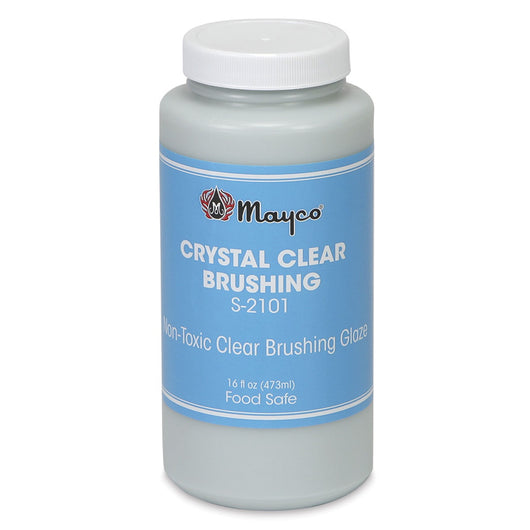
Natural Clear Transparent Brush Glaze 473ml
Mayco
Regular price
€27.00
Sale
Mayco clear glazes preserve and enhance the surface of your work. Functionally, clear glaze forms an impervious barrier that protects against liquids, dirt and abrasion. Aesthetically, our clear glazes provide a gloss or satin sheen over top of your colored glaze decoration. Please refer to specific product labels and our website for detailed instruction on using and storing clear glazes. These clear glazes are all non-toxic and food safe. This glaze is not intended for mid range use.
General Use
Brushing glazes differ from dipping versions as they contain organic additives, making the brushing glazes thicker, more viscous than dipping formulas. The amount of glaze deposited on bisque is primarily a function of glaze viscosity and the amount of time the bisque is left in the glaze. Pay careful attention to these two details which are critical to obtaining satisfactory results.
S-2101 Crystal Clear Brushing
Clean, clear surface. AP Non-toxic & Dinnerware safe. Luster compatible.
Usage Variations & FAQs
Q: What is a clear glaze?
A: Clear glazes are glass coatings used to completely seal the ware (decorated or undecorated, making the ware impervious to liquids. They are also used to boost the brilliance of the underlying color.
Q: Should I use a dipping or brushing clear glaze?
A: Choosing a dipping or brushing version of a dipping glaze is dependent on application preference, quantity of glazing and time. Mayco offers pre-made low fire clear glaze in both dipping and brushing formulas. Brushing clear glazes differ from dipping versions in that they contain organic additives, which make the brushing glazes thicker (viscous) than dipping formulas. These additives are meant to improve the flow of glaze from the brush and assist with the even-ness of application, enhancing the fired surface finish. The amount of glaze deposited on the ware is primarily a function of glaze viscosity and the number of applications. Typically 2 applications are required, allowing dry time between coats.
Dipping clear glazes contain fewer organic additives, making dipping glazes less viscous than their brushing counterpart. The amount of glaze deposited on the ware is a function of glaze viscosity and the amount of time left in the glaze. Often dipping glazes are preferred in a studio or production environment where a large quantity of ware is processed. To learn different dipping methods and tips, view our instructional video in YouTube.
Q: What does coefficient of expansion (COE) mean and how does it impact my choices of glazes, clay or bisque?
A: Glaze and clay/bisque bodies are both ceramic materials. During the firing process they expand and then contract together; the rate of expansion/contraction can be measured and mathematically stated as a coefficient of expansion.
